I believe in exfoliation. Utterly. Completely. It’s a religion to me. It is, I am convinced, the reason why my skin is in pretty good nick and smooth all over (you’ll have to take my word for that part…!)
You hear about exfoliation endlessly these days but it’s likely it’s been around for over 4000 years. It is a ludicrously simple idea (the human body is so genius) but first a teeny bit of biology to truly understand the why’s, when’s and how’s of exfoliation:
The skin is endlessly regenerating its cells and sending them from the lowest layer (the dermis) to the surface layer (the epidermis), but as these new fresh, vibrant cells travel outwards they slowly die and become saturated with keratin which then protects the skin from the outside world. (Keratin is a massively strong protein that is the main component of our hair, skin, nails and teeth. It’s the sulphur atoms that bond like no other to create flexible super strength and why hair whiffs when it burns…ok this is getting too involved but no knowledge is wasted I say!)
So, many thousands of dead cells are being shed every day and…create dust! I know I said no more science but, if you need any more incentive to exfoliate, think about the fact that most household dust contains huge amounts of dead human skin cells and the dust mites that eat them (and their faeces and their desiccated corpses…!) I shall leave you with that visual…
As we get older this skin renewal process, like just about everything else, slows down. The skin backs up with dead cells and the natural removal process begins to fail leaving rougher textures and dry, duller skin. Removing the outer layer of your skin reveals the fresher newer skin beneath and unclogs pores, and evens out the texture of your skin. It deep cleans your skin and can help prevent breakouts. So, it’s blatantly obvious isn’t it that exfoliating will help completely, and even trick your skin into thinking that it’s young again?!
The two main types of exfoliation are abrasive and chemical. Abrasive options are those that physically rub off the cells like sponges, loofahs and cloths or products with micro beads, crushed kernels, salt or pumice contained in them.
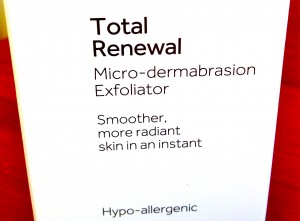 Microdermabrasion is a term applied, these days, to any process that scruffs off the surface layer of the skin but it refers to a mechanical process that involves an abrasion of the skin using crystal or diamond flakes and suction to carry away the detritus (and is used on the face, neck, arms and chest). Dermabrasion, however, is a term used for a surgical procedure usually performed under local anaesthetic and is the most intense (but has largely been replaced by laser technology).
Microdermabrasion is a term applied, these days, to any process that scruffs off the surface layer of the skin but it refers to a mechanical process that involves an abrasion of the skin using crystal or diamond flakes and suction to carry away the detritus (and is used on the face, neck, arms and chest). Dermabrasion, however, is a term used for a surgical procedure usually performed under local anaesthetic and is the most intense (but has largely been replaced by laser technology).
Chemical exfoliants will include acids like salicylic, glycolic, citric, malic, AHA’s (Alpha Hydroxy Acid) or BHA’s (Beta Hydroxy Acid) or fruit and other enzymes which fundamentally work to loosen the elements that hold the old dead surface cells together and thus allowing them to be washed away. Get to know these different acids so you know which are working better for your skin and then you can, more importantly, avoid the ingredients that are not working for your skin.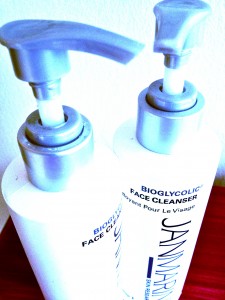
Basically, the main difference between AHA’s and BHA’s is that AHA’s are water-soluble only and BHA’s are oil soluble. The essential difference therefore is in their use. Logically, BHA’s are better for oily skin and where breakouts, blackheads and acne are more prevalent and AHA’s for all other skin types.
BHA in cosmetic items is essentially Salicylic Acid (its ancient historical use is traceable to Willow Bark) and is especially helpful in treating acne (although it is an all round anti-inflammatory too) because it can penetrate and break down oil and works it’s magic by opening clogged pores and neutralizing the bacteria in them.
AHA’s are in many, many cosmetic products so it’s important to make sure you’re not over doing the amount you’re putting on your face, especially. The five usual ones are Glycolic acid (from sugar cane), Lactic acid (from sour milk), Malic acid (from apples), Citric acid (from citrus fruits) and Tartaric acid (from grapes). They can be either synthetically derived or naturally occurring. AHA’s are in cleansers, moisturisers, foundations, eye creams, sunscreens etc. However, many products don’t list how much AHA is actually in them. Over the counter products cannot have more than 10% AHA, but looking at the ingredients list can give you a rough guide to the amount that there might be. If an AHA is listed as second or third then it’s likely it’s a stronger concentration. A key thought to bear in mind is that AHA’s have to be able to penetrate the skin, I mean actually be absorbed in some way to do their work. (Glycolic acid has the smallest molecular structure and so is considered to be the one that penetrates the skin the easiest which is why you see it so often in skin care products. I personally like it too. It suits my skin and I’ll be talking about it in a future post.) So, here’s the most important thing – AHA’s in a cleanser that you don’t leave on your face, and you end up washing it away before the absorption can happen, are clearly no good to you! Your exfoliating and your moisturising product is the best place to interact with the AHA. So consider the whole AHA picture within your product regime carefully and only use it where it is actually going to do you some good!
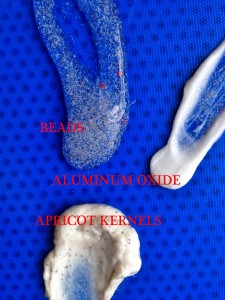 Exfoliating products containing an abrasive substance literally rub off the layers of your skin to reveal the newer skin. Thought and caution must go into this though as some scrubs can actually scratch and irritate the skin…especially if you’re a tad vigorous with your technique! Blemish prone skin is best left without abrasive exfoliators rubbing it and making it even more inflamed and irritable. It’s largely reported that apricot kernel type particles are the most ‘damaging’ as they are the roughest and can cause micro cuts (however, I use St Ives apricot face scrub and it’s great. Whether that’s a testament to the product or to my leathery skin I dunno…?!?) Beads made of polyethylene are smooth and therefore more gentle (not biodegradable though…oof there’s always something eh?) ‘Natural’ products that contain things like sugar, salt or baking soda are popular as they are naturally water-soluble and so are gentle and disperse quickly.
Exfoliating products containing an abrasive substance literally rub off the layers of your skin to reveal the newer skin. Thought and caution must go into this though as some scrubs can actually scratch and irritate the skin…especially if you’re a tad vigorous with your technique! Blemish prone skin is best left without abrasive exfoliators rubbing it and making it even more inflamed and irritable. It’s largely reported that apricot kernel type particles are the most ‘damaging’ as they are the roughest and can cause micro cuts (however, I use St Ives apricot face scrub and it’s great. Whether that’s a testament to the product or to my leathery skin I dunno…?!?) Beads made of polyethylene are smooth and therefore more gentle (not biodegradable though…oof there’s always something eh?) ‘Natural’ products that contain things like sugar, salt or baking soda are popular as they are naturally water-soluble and so are gentle and disperse quickly. 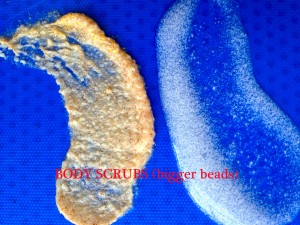 Sugar is especially good for sensitive skin (it’s nack all use for anything else as it’s poisonous so I’m glad to hear it has a use here…!) A third type of exfoliant has a crystal such as aluminium oxide in it and is usually found in products like over the counter microdermabrasion creams. It’s really, really hard and almost shaves off a layer of your skin and yet is still considered to be less damaging than kernels. Go steady and use common sense if you have sensitive skin. Avoid this method of exfoliating completely if you have any irritation.
Sugar is especially good for sensitive skin (it’s nack all use for anything else as it’s poisonous so I’m glad to hear it has a use here…!) A third type of exfoliant has a crystal such as aluminium oxide in it and is usually found in products like over the counter microdermabrasion creams. It’s really, really hard and almost shaves off a layer of your skin and yet is still considered to be less damaging than kernels. Go steady and use common sense if you have sensitive skin. Avoid this method of exfoliating completely if you have any irritation. 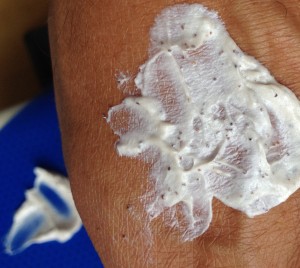
The product doesn’t have to contain the element that exfoliates, it can be the method by which it is applied that can be the source of exfoliation. The best examples being anything like face clothes, sponges or brushes. Again go easy with your technique and don’t scrape or scratch the skin.
Now then, here’s another very, VERY important bit! Your skin is your largest organ (sorry boys…) Some eastern medicines believe that it is a map of your health, not just your face but also the entire skin. Just exfoliating your face isn’t enough. The body needs to slough off these dead cells just as much and clearly you want your entire body’s skin to be happy don’t you? Happy and glowing and youthful as possible? Why not? If, you’re shaking your head and thinking well it’s all very well but when the frig am I going to have time to do all this cell removal, then here’s a delicious little tip that’ll transform, yes transform, your life let alone your skin. 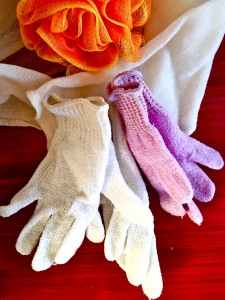 Get a pair of body scrubbing gloves from just about any high street supermarket or chemist (and they are cheap! Even the posh ones are only four quid!) and every time you shower slip them on and wash as normal. Ok, maybe not every time but two or three times a week. My Indian family are great exponents of doing the scrubbing, as-it-were, always towards the heart. If you’re not a shower person (I mean take baths instead rather than are just a dirt bag) then do the same but my personal experience is that you should do this after the bath as once you’ve swept the gloves over every inch of you (got to get my jollies somewhere…) you can’t rinse them in the bath water because the vast amount of dead cells, that you’ve just fabulously scrubbed from your body, will then be floating in the bath with you like fish food on a pond and it ain’t pretty.
Get a pair of body scrubbing gloves from just about any high street supermarket or chemist (and they are cheap! Even the posh ones are only four quid!) and every time you shower slip them on and wash as normal. Ok, maybe not every time but two or three times a week. My Indian family are great exponents of doing the scrubbing, as-it-were, always towards the heart. If you’re not a shower person (I mean take baths instead rather than are just a dirt bag) then do the same but my personal experience is that you should do this after the bath as once you’ve swept the gloves over every inch of you (got to get my jollies somewhere…) you can’t rinse them in the bath water because the vast amount of dead cells, that you’ve just fabulously scrubbed from your body, will then be floating in the bath with you like fish food on a pond and it ain’t pretty.
To really pound the point home I timed the putting on and taking off of the gloves in question to see if there would be any validity in the gripes and whinges from some of the lazier members of the audience. Sixteen seconds is the average total time. I timed the process for a week and the mean average time for putting the gloves on and taking them off is sixteen seconds!! SIXTEEN. Don’t even try to find a way to tell me you don’t have a sixteen second space in your routine to give yourself fabulous, touchable, strokeable, soft, glowing skin?!? Exactly. So, zip it…
Don’t use body scrub products (or the gloves) on your face, by the way, as the exfoliating particles will be bigger and rougher and not at all suitable for the more delicate skin on your face.
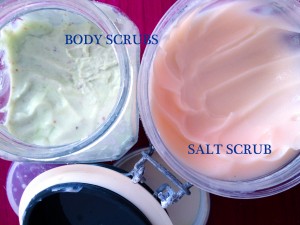 Exfoliation should be done after cleansing and before moisturising. That’s supposedly the holy trinity. You know your body best and you must learn to watch and respond to your skin. Deciding how often to exfoliate and what methods and products your skin seems to respond to better. I find that many times, and especially during the warmer months, I don’t need to moisturise and in fact over stimulate my skin into a grease feste if I do. Some cleansers (Eve Lom’s for instance) are oil based and if I use that I still don’t need to moisturise (even after exfoliation) or I wake up like I’ve been sleeping face down in a bag of chips (I haven’t! Ok, but it was only one time…sheesh, some people never let you forget…!) Maybe you only give your body a right good going over once a week? Or maybe, three less rigorous goings over a week…whichever, don’t over do it! There should be no irritation (although a freshly scrubbed limb might be a tad sensitive to hot water…just rinse cooler…!) and if your skin is over producing oils then it’s unhappy.
Exfoliation should be done after cleansing and before moisturising. That’s supposedly the holy trinity. You know your body best and you must learn to watch and respond to your skin. Deciding how often to exfoliate and what methods and products your skin seems to respond to better. I find that many times, and especially during the warmer months, I don’t need to moisturise and in fact over stimulate my skin into a grease feste if I do. Some cleansers (Eve Lom’s for instance) are oil based and if I use that I still don’t need to moisturise (even after exfoliation) or I wake up like I’ve been sleeping face down in a bag of chips (I haven’t! Ok, but it was only one time…sheesh, some people never let you forget…!) Maybe you only give your body a right good going over once a week? Or maybe, three less rigorous goings over a week…whichever, don’t over do it! There should be no irritation (although a freshly scrubbed limb might be a tad sensitive to hot water…just rinse cooler…!) and if your skin is over producing oils then it’s unhappy.
Any men reading this should note that exfoliating your beard pre-shaving is a wonder as it exposes the hair follicles and gives you an easier and better shave. Also if you’re hairy (I guess I shouldn’t exclude women in this…) then bear in mind that hair traps oil, sweat and dirt and an exfoliating body scrub or running yourself all over with the magic gloves (yes, men too…in fact it’s a totally unisex thing!) will keep everything pristine and unclogged. 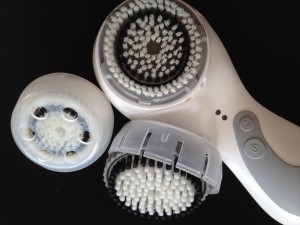
A final thought for now…everyone should think about running a long handled loofah over their back. All you lucky devils with a partner to scrub you down, make sure he/she gets a good lather up and gives it a good going over in lovely big circular motions. It’s worth mentioning the obvious that skin is different and therefore differently sensitive all over your body so get to know it and treat it appropriately. Yes your back can take a good firm motion but your stomach is more sensitive (thinner skin) so go easier.
Exfoliating might take a little extra work and planning but think about the fabulous trade off for better skin, less wrinkles and a youthful complexion. Don’t drive yourself mad but exfoliate as much as you can with the minimal irritation and don’t forget to moisturize! Feed that new exposed skin! Then go out and work it…!








